Again at Sea in 2004
As Passenger on a Freighter in the Baltic Sea
During my 30 year career as radio officer in the merchant fleet, I had not lost
contact with the sea through over 25 years service with Norddeich Radio, (DAN) but had not been on a sea-going ship since then. It was time to plan my annual vacation somewhat
differently… Through the internet I found the web page of a well-known German cargo ship tourist agent in Maasholm, which offered an extensive catalog of world-wide cargo ship
journeys. (www.zylmann.de ) I decided to book for a one-week trip in the Baltic Sea. The ship was called “Westwind,” sailing under the Antigua flag, (V2AP3) from Hamburg, through the Kiel Canal
to Gdynia/Poland and Klaipeda/Lithuania (the old German Memel), and back through the Kiel Canal to Bremerhaven and Hamburg.
The ship was contracted by the shipping company Baase in Nuebbel. The service by the
tourist agent was outstanding: I received a small master-plan of the ship, a plan of Hamburg Harbor with possible ship berthing locations, and a sketch of my cabin, which was the
unoccupied 2’nd Officer’s cabin. The cabin had two bunks, a separate shower with WC, and (surprise!) a small refrigerator.
The Westwind was a small container ship, 20 years old, 3,100 tdw,
101 meters long, and reached with 2400 hp 14 Knots. Having an amateur radio operator license, I wanted to operate at sea like I did more than 30 years ago, but with my own call, as
DL7DAN/MM. (MM means maritime mobile.)
I called the ship owner with this request, and received an immediate promise, but could not use a long wire or dipole,
and was limited to as short a vertical antenna as possible. |
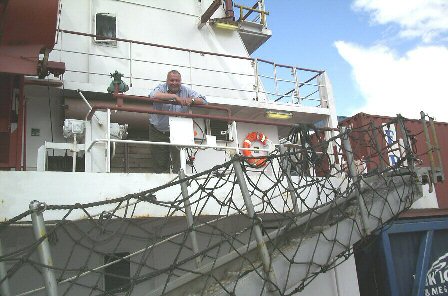
Again on board after 30 years |
I received a
call from the tourist agent with the ETA (estimated time of arrival) 24 hours before arrival of the ship in Hamburg, and to call the captain directly by cell-phone one hour before arrival
because the berthing place is always only known at the last minute. Thus, I made my way into Hamburg port. The berth was “Euro-Gate Burchardkai,” in the old Waltershofer
port. I had
thought to drive, as was the old custom, directly to the gangway to unload my suitcases. This was permitted only once! and the guard expelled me, then I was allowed to ride in the shuttle
bus from the stevedoring firm to the ship. The reason for this measure is that at the end of 2002 the international shipping organization, IMO, at the urging of the USA after the terrorist
attacks of 11 September 2001, introduced the so-called ISPS code. (International Ship and Haven Facility Security Code) These measures are in effect in all German ports, much to the regret
of the ships. During the entire down-time all outer doors must be locked on board and sealed, with the exception of one door in the vicinity of the passenger loading gangway, and a guard
must be at the door during the ship down-time. Records are kept of all visitors with time of arrival and departure. One can argue about the sense or nonsense of these restrictions. From
the sea-side the ship was totally unprotected, and a small boat could approach the ship with “intention of terror,” unhindered.
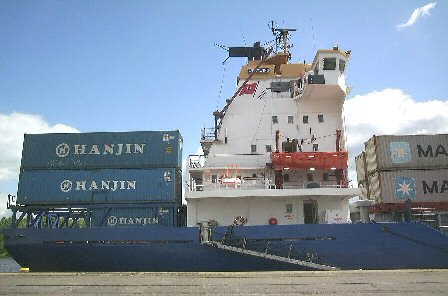
M/S "Westwind" in the port of Szczecin |
The crew consisted of 9 men: Captain, first and second officers, Chief, (Chief Engineer) cook, and deck and machine crew.
The Chief came from Lithuania. and the others from different parts of Poland. The captain spoke excellent German, and with the others one could do well enough
in English. All the crew members were extremely friendly. The atmosphere was to me very familiar, a little oil smell from the engine room, a little fragrance from the
galley,
and quietly humming auxiliary diesels. Apparently not much had changed in 30 years. When on-board, the captain informed me that Gdynia was not ready for
us, and we would sail directly to Klaipeda, and afterwards to Szczecin/Poland ( the old German Stettin ). This circumstance pleased me, as my father was born and
spent his youth in Stettin, and perhaps I could photograph my father’s old house? |
When running the ship out of Hamburg I was naturally on the bridge, in expectation of a large operation. No such thing: No port pilot, no Elbe pilot, no tug-boat. Due to the ship size and good German knowledge of
the captain there was no obligatory pilot on the Elbe or the Weser, and with the bow thruster the ship released easily from the jetty, thus no tug-boat. From Blankenese and Wilkommshoeft,
through the Brunsbuetteler locks, and the Kiel Canal, memories of earlier navigation came back, with some nostalgia. My cabin on-board was small, but was custom-made for my needs. Both
the room and shower with WC were in clean condition.
|
As to “radio enterprise on board,” the number one means of communication on board was D1 cell-phones, (GSM-Net) with D-Net fax-apparatus in a console on the bridge. On the
navigation deck a D-Net antenna was attached, which brought good reception. After my knowledge of this navigation ceased to exist, there was a continuous connection to Klaipedia/Lithuania
over this net as we ran out. There were no maritime radio discussions over UHF (ultra-high-frequency) excluding district radio on Channel 16, and the operating channels. In a small
separate radio room on the bridge there was the obligatory GMDSS
equipment, and VHF radio with DSC, digital selective calling. In addition there was a 2182 kHz monitor receiver installed on
the bridge, and a NAVTEX receiver for 518 kHz with integrated thermal printer for weather forecasts and nautical warnings. The navigation equipment was not commensurate with the age of the
ship, but also not the latest. There were no electronic sea-charts, rather they lay, as we knew them from “our” sea time, on the chart table. Since the ship sailed in automatic
service, the courses with course changes and distances were already drawn on the maps, and the courses with distances were entered into the auto-pilot, coupled with the GPS. If a necessary change
occurs, an acoustical signal alarms, and the watch-stander enters the new course into the autopilot. I kept a record of the course, and an experienced helmsman could not have kept the
course so accurately.
Indeed, it looked as though it had been drawn by a ruler.
For navigational support there were two radars with glare-free screens we could only dream about 30 years ago. |
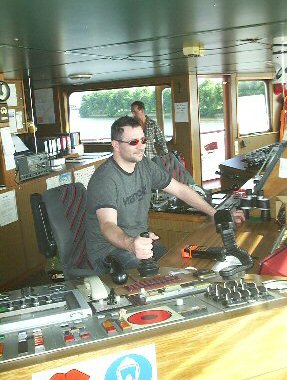
Captain and First Officer on the bridge.
The "Joystick"
replaces the conventional rudder. |
There was no rudder on the bridge in the conventional sense, rather it was driven by a “Joystick.”
The Baltic Sea passage was at first outstanding warm and sunny, then it was glory past with wind from the west with strength 8, and the ship rolling to
port, with a substantial following sea. I could still handle my notebook, which I carried for “amateur radio support, thus my fear of being seasick after 30 years was groundless, and the
tablets stayed in the cabinet.
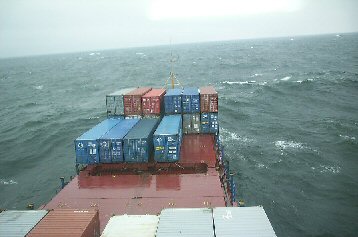
Gale Force 8 - 9 in the Baltic Sea |
Unfortunately the storm prevented immediately running into Klaipeda, and we had approximately three hours before the port entrance, steaming against the storm
and wind. Thus, we ran in at 21:30 with a downtime of only three hours. I did without going ashore as it would not have been worthwhile, unfortunately, as I would have enjoyed seeing the
old German Memel. A small episode: In Klaipeda
a container ship with black trunk and yellow superstructure was behind us on the jetty. The ship’s name was, “Borussia Dortmund,” surely a football-inspired ship owner.
(Ship
owner and soccer fan). The storm made us travel starting from Swinoujscie/Poland ( the old German Swinemünde) by the
Piastowski Kanal ( Kaiser Fahrt) in the Zalew Szczecinski (Stettiner Haff), where the wind was hardly felt. |
Szczecin made a very good impression, with over
500,000 inhabitants. As previously mentioned, my father grew there as son of one Customs Office Assistant, in the Main Customs Office. The captain gave assistance here, as he knew it
today is still the general customs office. The building was easy to find, and I took some photographs.
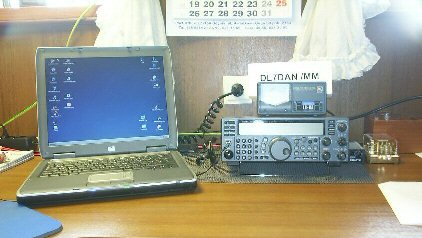
Amateur Radio Station on Board |
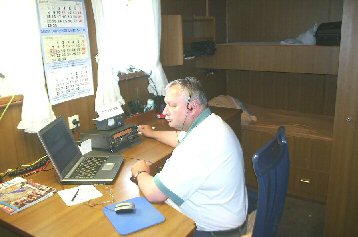
CW Operation from the Ships Cabin |
For friends of amateur radio, there are briefly some details: First, it was very nice to be once again in the Radio Room transmitting from sea to land. By
the way, I only worked with the Morse key, and didn’t even bring a microphone. I brought a Perth Outbacker vertical antenna, transceiver, power supply, and SWR bridge.
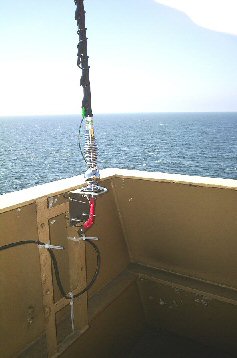
The fastening of the "Outbacker Perth" |
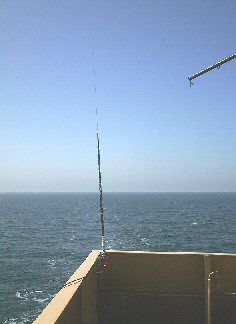
The 1,9 m long antenna |
The antenna was
installed on the navigation bridge approximately 22 meters above the water, on a spring mount, the antenna being 1.9 meters long. The storm often blew this delicate antenna down to 45°, but
had no effect on operation. Grounding took place in the cabin at the frame of the porthole. The suffix “MM” had a special effect: It was nearly like the golden Norddeich Radio times after
the A1 or A3 traffic call-up. I consciously worked slowly and had a few personal words for each station. As an additional service I gave the current QTH (location) in the old sailor
format…
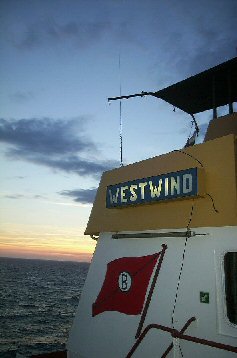
Evening mood in the Baltic Sea |
The return journey was made again by the Kiel Canal to Hamburg, and in Bremerhaven I left the ship after 7 days. It was a beautiful experience which will last in memory, which I
would gladly repeat, perhaps with a longer trip.
By the way, imitation is recommended!
Lastly, thanks to my former DAN colleagues, Dietrich Brandt (DL1BHM) and Onno Heyen (DL4BCE) who
supported me before the journey with advice and help and thanks to Richard Brunner (AA1P) for translating this site.
| Any questions ? |

|
 |
|









